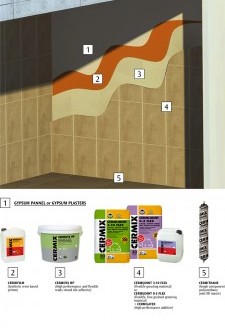Flexible tile adhesives should be used for tiling on gypsum board pannels, as the pannels have flexible structure.
Since application of cement-based adhesives to such kind of surfaces may lead to risky results (because of very high porosity property of the surfaces), it is recommended to use acrylic dispersion based tile adhesives. This type of adhesive bonds and hardens by losing the water in its structure. No priming is required before fixing.
For fixing select CERMIFIX HP.
The adhesive ready-mixed and no mixing is required.
It is in paste form and can be applied directly for tiling. Never add any additives (water, latex, etc.) into the ready-mixed paste.
Apply the adhesive on the substrate (for tile sizes >33x33 cm, adhesive should be buttered onto the tile back as well) with a suitable notched trowel to achieve the required bed thickness. Glass tiles, natural stones and marbles should be fixed with double buttering method. For efficiency, V5 or V6 type notched trowels are recommended.
In fixing transparent and light coloured tiles and natural stones, a sample application should be carried to observe the possibility of the formation of stain and shades.
The tiles must be fixed within the open time of adhesive and pressed on with a twisting and sliding action to achieve a good contact. The tile should be gently hammered with a rubber hammer in order to provide the stability of bonding and the adhesive to spread and fully cover the tile back. Lift an occasional tile after fixing to verify that the required contact is being achieved.
Do not tile on the joints within pannels and pannel-wall-floor intersections. These joints may allow movements which will cause deformations on the covering. Fill the joints with suitable profiles or mastics.
Excess adhesive must be cleaned off from the tiles and joints with a damp cloth or sponge before it hardens.
Grouting must be done at least 48 hours later after adhesive application, when the adhesive has set and dried.
For grouting application select CERMIJOINT 0-3 FLEX (for tile sizes <2,5x2,5 cm) or CERMIJOINT 3-10 FLEX. To improve the technical performance, it is recommended to add CERMILATEX into the mixing water in the ratio 1:3 (As for the mixing water; instead of 3 scales of water, 2 scales of water and 1 scale of CERMILATEX).
While applying cement based grouts, carefully follow the rules and instructions on product packaging and technical legends of the products. Do not add more water into the mixture or re-wet once the mixture is prepared. This will cause the set grout to be weak. It may also cause discrete holes and grains on grout surface, and surface discolouration and variation which will be more noticable with darker grouting colours.
For a easier application and to ensure full final product performance, the grout should be applied at an ambient temperature range of +10 °C - +25 °C.
Grouted surfaces must be protected for at least 24 hours from direct sunlight, frost and rain.
If any stains and residues remain after grouting, wait for 10 days and treat the tile with CERMINET tile cleaning material to loosen and remove these residues.
Expansion joints should be incorporated to allow for slight movements due to changes in temperature, humidity and thermal and mechanical loads formed on the surface and substrate. Expansion joints should be provided considering heat transmitting systems and insulation applications, floors exposed to heavy traffic and pedestrian loads, wideness of the area, where tiling meets other materials, along all internal corners, existing movement joints or changes in background material. As described above expansion joints absorbs the stresses formed between different movement capacities of overlapping materials. Thus, it prevents the deformations that may arise in the surface and covering. Expansion joints should be insulated by using proper profiles or mastics. Cementitous grouting materials are not appropriate for expansion joints.
Within pannels, in internal corners, overlapping wall coverings, wallfloor intersections and on areas > 3 m x 3m expansion joints should be applied. Expansion joints should have minimum width of 6-10 mm. Skirting should be fixed upon to the completion of tiling.
No coatings or coverings should be applied on the existing dilatation zones and structural expansion joints in buildings. These zones should be insulated by using proper profiles or mastics.
CERMITHANE mastic can be used to fill expansion joints.
When tiling on walls, the weight of tiles per m2 should not exceed 30 kg.
Porcelain tiles sized between 300 cm2 (15x20 cm) to 900 cm2 (30x30 cm) are limited up to 4 m for facade tiling. Please consult to the technical support for larger sized tile applications at higher elevations.
